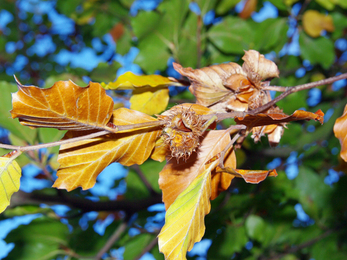The seasonal transformation of our deciduous trees is one of nature’s most joyous spectacles.
To stroll through a woodland in autumn is a visual delight as trees switch their verdant summer coats for glorious bursts of gold, copper and bronze.
Witnessing such a riot of colour is not only beautiful, but good for our wellbeing. In a Forestry England survey, 97% of people said looking at autumn colours lifts the mood.
The common beech (Fagus sylvatica) is a majestic species, aptly known as the queen of trees, and one that boasts a dramatic shift in the beauty of its foliage.
They’re among the first trees in the UK to turn in colour, taking on a blazing auburn shade before eventually shedding its dying leaves.
Mature beech trees can grow to heights of 40m or more – the tallest native UK tree is a beech – with a dome-like crown and a sprawling canopy.
In south and central England, beeches are the dominant woodland tree, favouring the free-draining chalk and limestone soils.
Beeches also have considerable value to wildlife, providing food and shelter for many different species.
One of the most fascinating interactions beech trees have with wildlife, as highlighted recently on Autumnwatch, involves a moth that feeds solely on its leaves.
The small beech pygmy (Stigmella tityrella) is relatively indistinct as an adult moth, but its caterpillars can be identified as they create visible S-shaped trails in beech leaves.
The moth lays its tiny eggs inside the leaf and once the larva emerges it begins to feed, leaving a squiggly trail in its wake that scientists politely call ‘frass’ (excrement). To identify these mines, it helps to hold the leaf up to the light.



